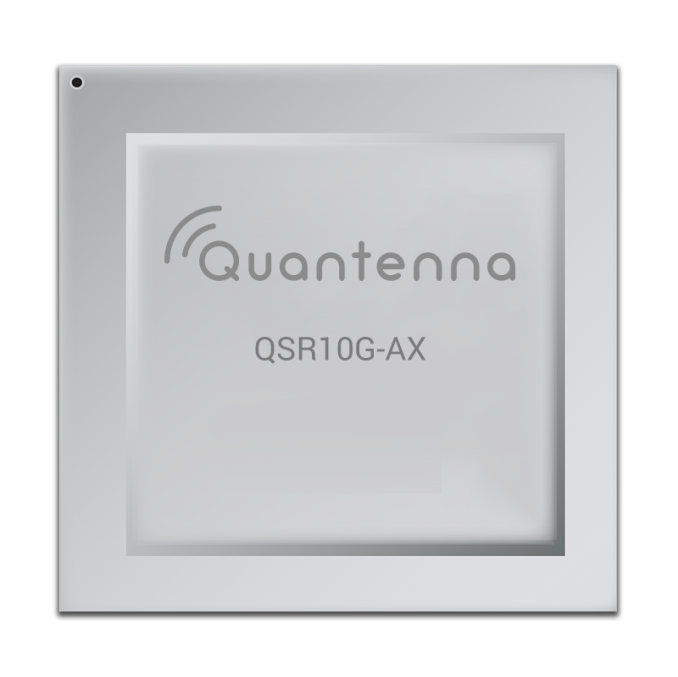Quantenna Announces 802.11ax Draft 1.0-Compliant Wi-Fi Chipset
by Anton Shilov on October 19, 2016 5:00 PM EST
Quantenna this week introduced the industry’s first 802.11ax Draft 1.0-compliant Wi-Fi chipset for access points. The QSR10G-AX is pin-to-pin compatible with Quantenna’s commercial QSR10G Wave 3 802.11ac-compliant Wi-Fi platform and can thus be easily integrated into existing APs (e.g., routers). The next-gen 802.11ax Wi-Fi standard promises to improve spectral efficiency of Wi-Fi operation in dense deployments and also to increase maximum theoretical bandwidth of Wi-Fi networks to around 10 Gbit/s.
Wi-Fi nowadays is a pervasive technology that is used by loads of different devices. Every office or residential building has tens of Wi-Fi APs visible and many people carry two or more of Wi-Fi-enabled devices with themselves (a smartphone, a laptop, most recently, smart watches). As a result, the number of connections that every AP needs to handle is getting higher every year, which requires higher spectral efficiency and more channels to connect devices. In the recent years the 802.11 standard introduced multiple ways to improve spectral efficiency of Wi-Fi, including multiple-input multiple-output antennas (MIMO), multi-user MIMO (MU-MIMO), higher order modulation and so on. The next-gen 802.11ax will add OFDMA (Orthogonal Frequency-Division Multiple Access) to allow different devices to be served by one channel, by dedicating different sub-carriers for individual client devices.
Quantenna’s QSR10G-AX is one of the industry's first 802.11ax Draft 1.0-compliant Wi-Fi chipsets, and supports the major features of the upcoming standard (including OFDMA, 1024-QAM and so on). Furthermore, to simplify deployment, it can be installed into existing designs due to pin-compatibility with the current QSR10G chipset. From a physical standpoint, devices based on the QSR10G-AX will use Quantenna’s 12-stream Wave 3 802.11ac dual-band Wi-Fi platform, which offers 8 streams in the 5 GHz band and a further 4 streams in the 2.4 GHz band. This essentially means that manufacturers using the QSR10G can simply throw in a more advanced chip and build an 802.11ax Draft 1.0-compliant router.
Right now, Quantenna does not specify the speeds that devices based on its QSR10G-AX will be able to provide, primarily because a lot will depend on actual client equipment. In the best case scenario with the currently available devices we are looking at 1733 and 2167 Mbps using four 802.11ac streams with 600, 800 and 1000 Mbps per stream. Nonetheless, keep in mind that the whole point of the 802.11ax is not to skyrocket maximum bandwidth (even though, maximum bandwidth remains important and does improve), but to ensure the ability to robustly serve the greatest number of clients using a single AP.
Meanwhile, the availability timeframe for such routers is unknown. Quantenna plans to make the QSR10G-AX chip available to its partners in early 2017. Then, it is going to take them some time to ensure that everything operates as planned (an uneasy thing to do due to lack of 802.11ax-compliant client equipment) and only then actual devices are set to hit the market.
Source: Quantenna











20 Comments
View All Comments
tipoo - Wednesday, October 19, 2016 - link
"also to increase maximum theoretical bandwidth of Wi-Fi networks to around 10 Gbit/s."'gigabit' wifi aka AC got me to 250-350Mbits real world, so a theoretical 10Gbits...Well, we finally have actual gigabit wifi I guess?
dsumanik - Wednesday, October 19, 2016 - link
Well also, remember for 10 gigabit to be fully realized both the client and the server need to be able to internally read/write at the required speeds to saturate the total wifi bandwidth, which isn't going to happen on mechanical storage, or even sata3 SSD's (except for raid array).I seem to recall getting similar ~300mb/s when copying from my server to my workstation DAS on an 802.11AC connection, still below gigabit but definitely sufficient enough for most applications, and 3x faster than 1gb hardwired
dsumanik - Wednesday, October 19, 2016 - link
woops meant 3x faster than 10mbs hardwireddoggface - Wednesday, October 19, 2016 - link
Try again?close - Thursday, October 20, 2016 - link
Most people look at the speed on the box and expect to see that from a single device/connection, when it's actually spread over 4 streams. Add to that the real-world efficiency and you have a recipe for disappointment with people expecting to get 120MBps to their device and only getting 50MBps.But finally, with this thing some of Anandtech's readers might actually be able to stream a video to their TV... o_O
jsntech - Wednesday, October 19, 2016 - link
What sort of hardware and distances are you running? AC usually gets me 600-800 Mbit/sec actual speed, albeit at pretty short distances.iwod - Thursday, October 20, 2016 - link
I think they will need to start advertising those as capacity. You have a total 10Gbps between all devices OR an super unrealistic single devices with 8 antenna. ( 10Gbps was using 8x8 MIMO ).802.11ax bumps the 1x speed from 433Mbps in AC to 600Mbps. So you can see the difference is pretty small. But it the way it handles multiple devices, and spectral efficiency, taking all the lessons learned in 4G and 4.5G, means in real world you are likely to see much faster speed.
802.11ax is going to have 8x8 antenna as part of the standard, ( compared to 802.11ac as wave 2 ) and working on 16x16.
If we assume the smartphones to stay with 2x2 Antenna design, this would mean 1.2Gbps speed, and i expect with all the improvement and non spectral efficiency environment we could get 800Mbps+ in realworld.
WatcherCK - Wednesday, October 19, 2016 - link
What sort of connection are you going to need to budget for an access point based on this chipset for example or an 802.11ad capable AP? Assuming a worst case scenario in a heavily traffic'd business environment, will we be seeing commercial AP with a 10Gbit uplink (looks like Edimax have the WAP2600X 10GbE)?That ends up being a hell of alot of bandwidth feeding into your wireless environment, what do people budget in terms of infastructure for updates or new rollouts for APs nowadays?
hechacker1 - Wednesday, October 19, 2016 - link
We're deploying multi-gig switches for current AC wave2 clients. The cost isn't that much more for the switch. It'll supply up to 5Gbps over ethernet, which is more than plenty for the real world AC wireless APs.Having ton of bandwidth at the AP is more about being able to share the air time and put more clients on it. At the uplink our wireless bandwidth usage is fairly low.
iwod - Thursday, October 20, 2016 - link
There is Nbase-T offering 2.5/ 5 Gbps uplink. While it doesn't fit 10Gbps, it is still plenty in 90% of the situation. Of coz i do hope 10GBase-T will drop in price.